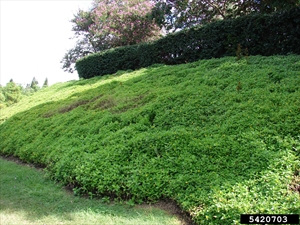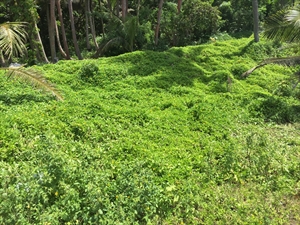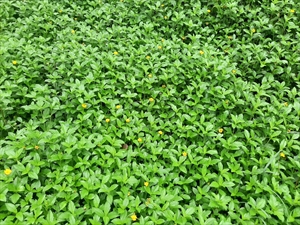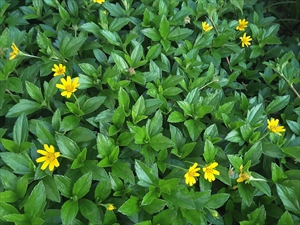Wedelia; there are many other names: Bay Biscayne creeping-oxeye; creeping daisy; creeping wedelia; Singapore daisy; trailing daisy; or yellow dots.
Pacific Pests, Pathogens and Weeds - Online edition
Pacific Pests, Pathogens & Weeds
Wedelia (447)
Sphagneticola trilobata. It was known previously as Wedelia trilobata. It is a member of the Asteraceae.
Africa, Asia, North, South and Central America, the Caribbean, Europe, Oceania. It is recorded from Australia, American Samoa, Cook Islands, Federated States of Micronesia, Fiji, French Polynesia, Guam, Kiribati, Marshall Islands, Nauru, New Caledonia, Niue, Northern Mariana Islands, Palau, Papua New Guinea, Samoa, Tokelau, Tonga, and Vanuatu.
Wedelia is native to Mexico, Central America, the Caribbean and tropical South America.
A very important invasive weed; a perennial creeping plant forming extensive, dense ground cover, crowding out other species (Photos 1-4). A weed of urban bushland, closed forests, forest margins, open woodlands, waterways, lake margins, wetlands, roadsides, disturbed sites, waste areas, vacant lots, and coastal sand dunes in tropical and sub-tropical regions. It may also grow into lawns, footpaths and parks from nearby gardens. Said to prefer well-drained, moist soil, and sunny areas, but also reported to be equally suited to dry sites. In the Pacific islands, it has become invasive along streams, canals, the margins of mangrove forests and in coastal vegetation.
Usually 15-30 cm tall, but occasionally up to 70 cm. Stems, green, sometimes hairy, growing up to 2 m long. Leaves in pairs, each with three lobes (centre one larger), glossy, with saw-like (or 'toothed') margins and without leaf stalks (Photo 5). Short branches, 3-15 cm long, develop off the stems producing bright yellow daisy-like flowers, 20-30 mm across, borne singly (Photos 5&6). Each flowerhead has 8-13 flowers (Photo 7). The outer ones each have a yellowish petal-like leaf, 6-15 mm long, with finely toothed tips; there are smaller tubular flowers in the centre. Narrow, green modified leaves are present at the back of the flowerheads, called bracts.
Spread is by stems or stem fragments that root from nodes (the swelling at the base of each leaf) as they touch the ground. The fragments spread in garden waste, by slashing by mowing, and during floods. Viable seeds are said to be rare; however, 17% viability has been reported from Fiji. Spread over long distances is by people moving the plant as an ornamental.
Wedelia is a significant invasive weed. Its main impact is the damage it causes to the environment and to biodiversity. It grows rapidly, excluding other vegetation, as well as smothering native species; this is seen in Pacific island countries, the Caribbean, the USA, West Africa, and Asia. There is an economic impact, too: the cost of control of this invasive weed, although exact figures are unavailable.
Often used as an ornamental. It is also used a ground cover. Medicinal use in remedies for coughs and colds.
BIOSECURITY
There is a high risk of introduction of this weed. Countries not yet infested by wedelia should consider all likely pathways for entry, and apply quarantine measures accordingly. Special consideration should be given to people spreading this weed as an ornamental, for ground cover (it is readily available via the internet), or for use in traditional medicines. Sphagneticola trilobata is a restricted invasive plant under biosecurity acts in some parts of Australia; this means - a person must not release these invasive plants into the environment, give away or sell as a plant or something infested with its seeds.
Sphagneticola trilobata is among the 100 of the World's Worst Invasive Alien Species compiled by the Global Invasive Species Database, maintained by the IUCN Invasive Species Specialist Group, 2020.
BIOLOGICAL CONTROL
Little known.
CULTURAL CONTROL
- Physical & Mechanical
- Slashing will slow growth, but not prevent it; note, stems pieces will root and form new plants; they should be collected and burnt.
-
Hand-pulling is effective on small areas where follow-up is possible to control seedlings and plants growing from stem pieces.
-
Stripping the top few cms of soil is effective, but costly, and requires the same post-treatment care as hand-pulling.
CHEMICAL CONTROL
In Australia, glyphosate; metsulfuron-methyl (and Fiji); and glyphosate + metsulfuron-methyl are registered (or under permit), but follow-up applications are said to be necessary as some underground stems will survive and regrow. In other countries, recommendations also include, 2,4-D; dicamba; triclopyr.
--------------------
Note, EU approval to use glyphosate ends in December 2022; its use after that date is under discussion.
____________________
When using a pesticide, always wear protective clothing and follow the instructions on the product label, such as dosage, timing of application, and pre-harvest interval. Recommendations will vary with the crop and system of cultivation. Expert advice on the most appropriate herbicides to use should always be sought from local agricultural authorities.
AUTHORS Grahame Jackson, Aradhana Deesh & Mani Mua
Adapted from Singapore daisy (Sphagneticola trilobata) (2018) Weeds of SE Qld and Northern NSW. Lucidcentral. (https://www.lucidcentral.org/editors-pick-animal-and-plant-identification-keys/key-to-weeds-of-se-qld-and-northern-nsw); and additional information from CABI (2019) Sphagneticola trilobata (wedelia). Invasive Species Compendium. (https://www.cabi.org/isc/datasheet/56714); and from Sphagneticola trilobata (2019) Wikipedia. (https://en.wikipedia.org/wiki/Sphagneticola_trilobata). Photo 2 Forest & Kim Starr, Starr Environmental, Bugwood.org. Photo 5 Ronggy (2017) Sphagneticola trilobata in Singapore. Photo 6 Hans Hillewaert (2006) Sphagneticola trilobata (L). Pruski. Bay Biscayne Creeping-oxeye at Woodford Hill Beach, Dominica, W.I.
Produced with support from the Australian Centre for International Agricultural Research under project HORT/2016/185: Responding to emerging pest and disease threats to horticulture in the Pacific islands, implemented by the University of Queensland, in association with the Pacific Community and Koronivia Research Station, Ministry of Agriculture, Fiji.










